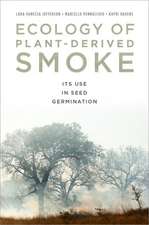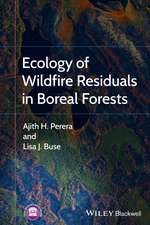Modern Agriculture and the Environment: Proceedings of an International Conference, held in Rehovot, Israel, 2–6 October 1994, under the auspices of the Faculty of Agriculture, the Hebrew University of Jerusalem: Developments in Plant and Soil Sciences, cartea 71
Editat de David Rosen, E. Tel-Or, Y. Hadar, Y. Chenen Limba Engleză Paperback – 6 noi 2012
Din seria Developments in Plant and Soil Sciences
- 18%
 Preț: 1225.94 lei
Preț: 1225.94 lei -
 Preț: 391.79 lei
Preț: 391.79 lei - 18%
 Preț: 1225.94 lei
Preț: 1225.94 lei - 18%
 Preț: 1228.29 lei
Preț: 1228.29 lei - 18%
 Preț: 1246.95 lei
Preț: 1246.95 lei - 24%
 Preț: 1073.18 lei
Preț: 1073.18 lei - 18%
 Preț: 970.70 lei
Preț: 970.70 lei - 24%
 Preț: 1073.76 lei
Preț: 1073.76 lei -
 Preț: 396.24 lei
Preț: 396.24 lei -
 Preț: 386.81 lei
Preț: 386.81 lei - 15%
 Preț: 699.93 lei
Preț: 699.93 lei -
 Preț: 384.86 lei
Preț: 384.86 lei - 18%
 Preț: 1221.69 lei
Preț: 1221.69 lei - 18%
 Preț: 1233.06 lei
Preț: 1233.06 lei -
 Preț: 399.12 lei
Preț: 399.12 lei - 18%
 Preț: 1227.67 lei
Preț: 1227.67 lei -
 Preț: 383.93 lei
Preț: 383.93 lei - 18%
 Preț: 1826.85 lei
Preț: 1826.85 lei - 18%
 Preț: 1232.09 lei
Preț: 1232.09 lei - 15%
 Preț: 646.94 lei
Preț: 646.94 lei - 18%
 Preț: 1231.47 lei
Preț: 1231.47 lei - 15%
 Preț: 650.55 lei
Preț: 650.55 lei - 15%
 Preț: 638.24 lei
Preț: 638.24 lei - 18%
 Preț: 955.08 lei
Preț: 955.08 lei -
 Preț: 385.61 lei
Preț: 385.61 lei -
 Preț: 382.36 lei
Preț: 382.36 lei -
 Preț: 407.98 lei
Preț: 407.98 lei -
 Preț: 393.35 lei
Preț: 393.35 lei - 18%
 Preț: 1224.54 lei
Preț: 1224.54 lei - 18%
 Preț: 1222.01 lei
Preț: 1222.01 lei - 18%
 Preț: 1228.15 lei
Preț: 1228.15 lei -
 Preț: 382.95 lei
Preț: 382.95 lei - 18%
 Preț: 1227.84 lei
Preț: 1227.84 lei
Preț: 409.69 lei
Nou
Puncte Express: 615
Preț estimativ în valută:
78.39€ • 81.85$ • 64.88£
78.39€ • 81.85$ • 64.88£
Carte tipărită la comandă
Livrare economică 04-18 aprilie
Preluare comenzi: 021 569.72.76
Specificații
ISBN-13: 9789401062794
ISBN-10: 940106279X
Pagini: 672
Ilustrații: XXI, 646 p.
Dimensiuni: 160 x 240 x 35 mm
Greutate: 0.93 kg
Ediția:Softcover reprint of the original 1st ed. 1997
Editura: SPRINGER NETHERLANDS
Colecția Springer
Seria Developments in Plant and Soil Sciences
Locul publicării:Dordrecht, Netherlands
ISBN-10: 940106279X
Pagini: 672
Ilustrații: XXI, 646 p.
Dimensiuni: 160 x 240 x 35 mm
Greutate: 0.93 kg
Ediția:Softcover reprint of the original 1st ed. 1997
Editura: SPRINGER NETHERLANDS
Colecția Springer
Seria Developments in Plant and Soil Sciences
Locul publicării:Dordrecht, Netherlands
Public țintă
ResearchCuprins
Section I: Towards Environmentally Acceptable Pest Management.- 1. Safer and more effective insecticides for the future.- 2. From Homo economicus to Homo ecologicus: towards environmentally safe pest control.- 3. Classical biological control: an environmental boon or bane?.- 4. Soil disinfestation: environmental problems and solutions.- 5. Minimizing environmental damage originating from pesticide utilization: abiotic photochemical control and remediation.- 6. Neem, eco-friendly, IPM-compatible plant-derived bioinsecticide: some new findings.- 7. Utilization of scorpion insecticidal neurotoxins and baculoviruses for the design of novel selective biopesticides.- 8. Nitrogen fixing cyanobacteria as BTi toxin genes delivery system — a biotechnological approach to control malaria mosquitoes.- 9. Structure-function analysis of PBAN/MRCH: a basis for antagonist design.- 10. Estimation of metolachlor volatilization from agricultural fields using a micrometeorological approach.- 11. Titanium dioxide photocatalysis for the treatment of contaminated waters.- Section II: Fertilisers in Agroecosystems.- 12. Site-oriented ecosystem management: precondition to reducing the contamination of waters and the atmosphere.- 13. Minimising surface and ground-water pollution from fertiliser applications.- 14. Considerations in fertiliser application to prevent ground-water contamination.- 15. Application of controlled release fertilisers in the Florida citrus industry.- Section III: Environmental Aspects of Aquaculture.- 16. Aquaculture and the environment: change and challenge.- 17. Biological removal of inorganic nitrogen and organic matter in closed, intensive fish culture systems.- 18. Ultrastructure and cellular activity of fish skin in metal-polluted water.- Section IV: Modelling ofAgricultural Pollution.- 19. Modelling pesticide transport in porous media.- 20. Comparative ecosystem research as a basis for agro-ecological modelling.- 21. Application of EPIC within an integrated modelling system to evaluate soil erosion in the Canadian Prairies.- 22. A model to predict the release rate of nitrogen from polymer-coated urea.- Section V: Wastewater Treatment and Irrigation.- 23. Sewage sludge: land utilisation and the environment: toxic organic considerations.- 24. New technologies for disinfection of domestic effluents for agricultural reuse.- 25. Effects of irrigation with secondary sewage effluent on the transport of soil-borne pesticides.- 26. Early detection of irrigation environmental risks using monitoring manholes: a case study of the Southern Ukraine.- 27. Use of wastewater from livestock farms for irrigation in Yugoslavia.- Section VI: Recycling of Municipal and Agricultural Wastes.- 28. Composting and recycling of organic wastes.- 29. Impacts of compost quality on plant disease severity.- 30. Suppressiveness of municipal solid waste composts to plant diseases induced by soilborne pathogens.- 31. On the agronomic use of municipal solid waste compost: principles and applications.- 32. Chemical and electron spin resonance properties of municipal solid waste composts.- 33. Variations with pedoclimatic conditions of an anaerobically digested liquid sewage sludge C mineralisation and its N-NO3-availability.- 34. Solid waste management in Israel.- Section VII: Pollution by Heavy Metals.- 35. Biofiltration of heavy metals by the aquatic fern Azolla.- 36. Modelling the mobilising effect of olive mill wastewater on heavy metals adsorbed by a soil.- 37. Soil microbial biomass as marker of heavy metal contamination and bioavailability.- 38. Copper andlead species in soil and their uptake by plants when applied as carbonates.- 39. Levels of copper, zinc and manganese in the vineyard soils of Dão wine region — Portugal.- Section VIII: Bioremediation.- 40. Bioremediation in agriculture: dream or reality?.- 41. Microbial transformation of pesticides in agricultural soil.- 42. Biological atrazine destruction mediated by bacteria.- 43. Removal of lead from aqueous solutions by a Brevibacterium strain.- 44. Polycyclic aromatic hydrocarbon degradation by white rot fungi.- 45. Potential utilisation of phenoloxidases immobilised in organic gels for decontamination of polluted sites.- Section IX: Economic and Policy Aspects of Natural Resources.- 46. Economics and sustainable development.- 47. Homogeneity and heterogeneity of bio-resources in economic models.- 48. Problems and prospects in the political economy of trans-boundary water issues.- 49. Australian decentralised water allocation.- 50. The practical impact of ecological chemical principles.- 51. Reuse of effluent: Israel as a model.
Recenzii
`This wide coverage of different aspects of the environmental problems related to agriculture will be a valuable text for agriculturists, policy makers and environmentalists as well as for students and researchers dealing with soil productivity.'
Agrochimica, XLI:5 (1997)
Agrochimica, XLI:5 (1997)












